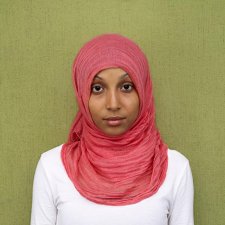What is it that appeals to me about taking photographs of people? Well, apart from defining it, it must be really strong, because right from the very beginning I was drawn to it. Not only was I drawn to photographing people I was drawn to looking directly into the faces of the people I was photographing. Especially to those 19th-century photographs of people standing in front of the camera staring back... and the fact that they were so consciously aware that they were standing there, and they were going to see an image of themselves from the outside.
Early photographic images of people would have been the first time where there was a more... democratisation if you like, of people seeing themselves from the outside. And so part of my work is always echoing back to that.
Right from the beginning, I was stripping portraiture back to some sort of bare essence. I knew I wasn't going to make a big thing about framing each image differently. I started to impose a structure on to the work that ultimately still remains today.
So I was drawing on life around me, fellow artists, writers, drug addicts, most of us living then still a more marginal life. I call my life 'village life' but I'm referring to the village life in an urban society where you've got these layers and cross-layers of different sub-groups who you're working in and amongst and responding to.
In the process, you're not really trying to convey all sorts of strong aspects of "What's this person's personality? How are they different from other people?" You're really looking quietly at the human condition, and real life doesn't allow much of that. We have a way of moving through conversations here, there and everywhere, but we rarely have this chance to quietly look into the face of another human being. And if you like my life's work has been centred around that slightly unerring process.















